 |
 |
 |
| |
Efficacy and Safety of Darunavir/ritonavir versus Lopinavir/ritonavir in ARV Treatment-Naive HIV-1-Infected Patients at Week 48:
ARTEMIS (TMC114-C211)
|
| |
| |
Reported by Jules Levin
ICAAC, Sept 17-20, 2007, Chicago
DeJesus E, Ortiz R, Khanlou H, Voronin E,
Van Lunzen J, Andrade-Villanueva J, Fourie J,
De Meyer S, Haley M, Lefebvre E,
Vanden Abeele C, Spinosa-Guzman S
689 treatment-naive patients were randomized to either darunavir/r 800/100mg once-daily plus tenofovir 300mg and FTC 200mg (n=343) or lopinavir/r (Kaletra) 400/10mg bid or 800/200mg qd plus tenofovir 300mg and FTC 200mg (n=346).
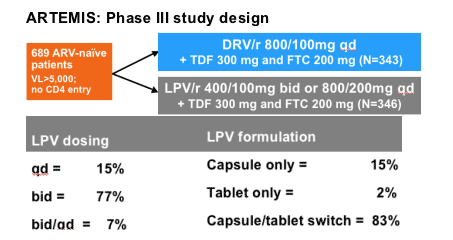
Dosing was based on regulatory approval; switch was made
according to local regulatory approval and drug availability. The table above says LPV dosing was 15% qd, 77% bid, and 7% bid/qd; and LPV formulation: 15% capsule only; 2% tablet only; capsule/tablet switch=83%.
AUTHOR CONCLUSIONS
The use of once-daily DRV/r 800/100mg + TDF/FTC in treatment-naive patients:
--resulted in excellent virologic and immunologic responses
--provided suitable exposure in all patients
--was well tolerated, with a favorable safety profile
In comparison to the LPV/r arm* in treatment-naive patients:
--For efficacy, DRV/r 800/100mg qd was non-inferior in the overall population, and superior in patients with high VL
DRV/r had lower incidence of common GI toxicities and triglyceride elevations
*LPV/r arm included: LPV/r 400/100mg bid or 800/200mg qd, capsule and tablet formulations
ARTEMIS: Study objectives
Primary end point
--Proportion of patients with an HIV RNA <50 copies/ml at Week 48
Primary objective
--demonstrate non-inferiority of DRV/r qd vs LPV/r based on that primary end point
The trial was designed as a non-inferiority study, in which the two drugs would be judged equivalent if there was less than a 12% difference in efficacy between the study arms, Dr. DeJesus said.
Secondary objectives
--evaluate long-term safety, tolerability and durability of virologic responses
--compare immunologic responses conduct pharmacokinetic evaluations

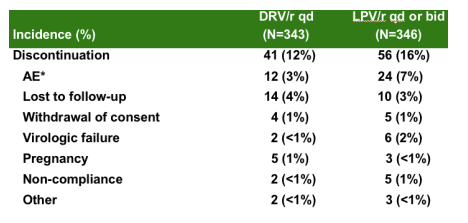
Table includes all data up to the point when the last patient reached week 48 Mean exposure was 56 weeks (range 0-83 weeks)
ARTEMIS: Viral load <50 copies/mL
to Week 48 (ITT-TLOVR)
For the purposes of the non-inferiority analysis, Dr. DeJesus said, the difference was estimated to be 5.6% -- within the 12% margin and significant at P<0.0001.
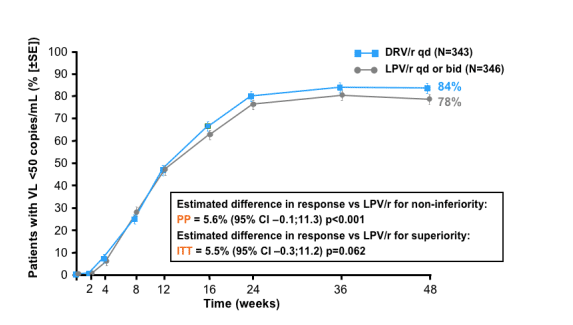
However, the difference fell just short of statistical significance when it came to superiority, he said.
On the other hand, he noted, for patients who began with viral loads of at least 100,000 copies, darunavir was significantly better:
-- 79% of darunavir patients with high viral loads met the endpoint, compared to 67% of the lopinavir patients, which was significant at P<0.05.
--In contrast, there was no significant difference if viral loads were lower than 100,000 copies -- 86% for darunavir versus 85% for lopinavir.
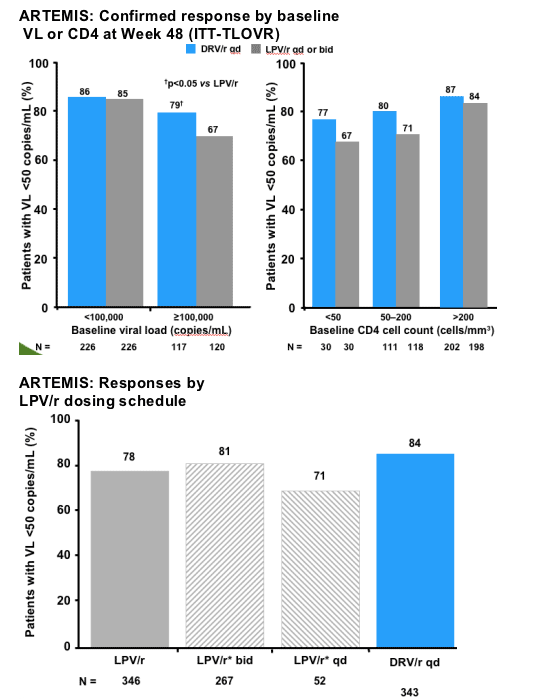
*27 patients receiving LPV/r bid and qd during the study were excluded from this analysis
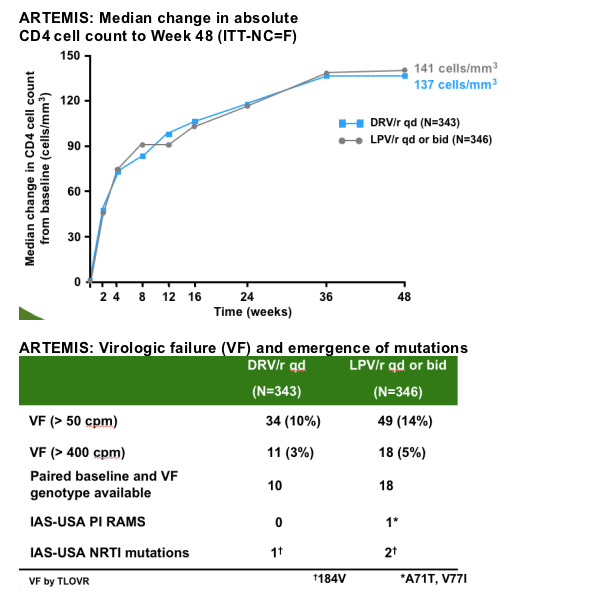
7% of darunavir patients had gastrointestinal side effects, compared with 14% of lopinavir patients, which was significant at P<0.01. Of those GI side effects, patients on lopinavir had a significantly higher incidence (at P<0.05) of diarrhea -- 10% versus 4%. Although Kaletra is associated with GI side effects, once-daily kaletra dosing is associated with more GI side effects than twice-daily Kaletra dosing.
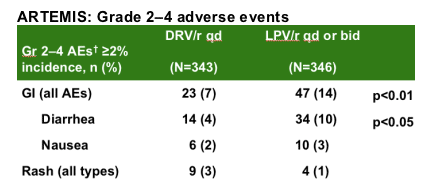
At least possibly related to study drug, excluding laboratory-related events
No renal SAEs and no treatment discontinuations due to renal AEs
Reported in the tables below, Kaletra use was associated with higher rate of grade 2-4 total cholesterol (23% vs 13%) and triglycerides (11% vs 3%). The total cholesterol/HDL ratio did not change throughout the study for both treatment groups because although there was an increase in total cholesterol with Kaletra use the HDL also increased.
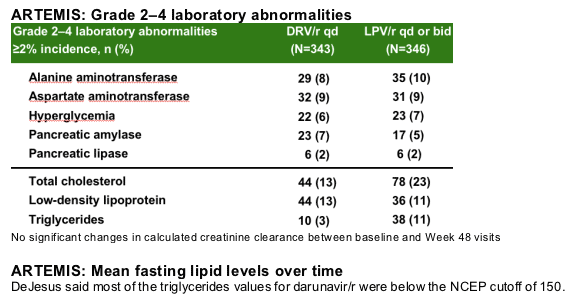
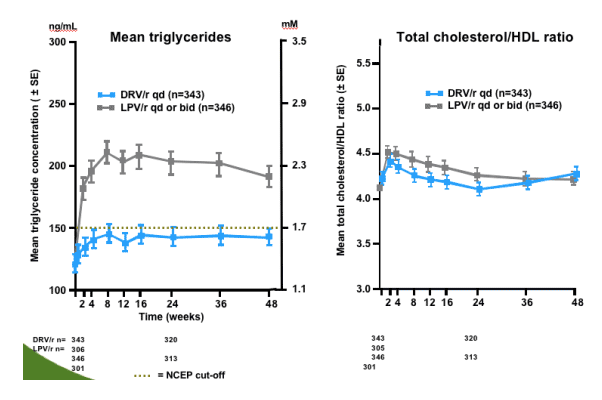
ARTEMIS: DRV plasma concentrations
for DRV/r 800mg/100mg
Week 4, 24, and 48 PK analyses was performed. Dejesus said, the data shown in this presentator was the week 4 data but the data from all 3 timepoints is similor; the trough concentrations observed in these patients were 'way above the EC50' needed to suppress wild-type virus adjusted for protein binding, 'demonstrating and supporting the long-half life darunavir/ritonavir of 14 hours'. DeJesus said, in addition the total patient population was studied, we have the median, IQR and the range; 'even patients with the lowest trough concentration has several fold higher concentration than the EC50 needed to suppress wild-type virus' (EC50=55 ng/ml for wild-type virus [adjusted for protein binding]).
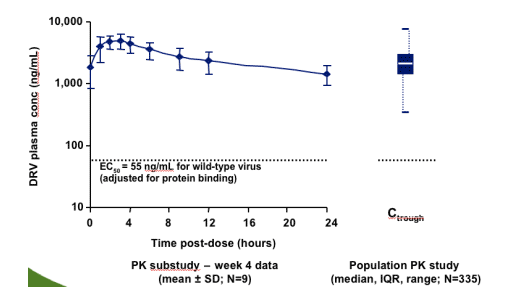
|
| |
|
 |
 |
|
|